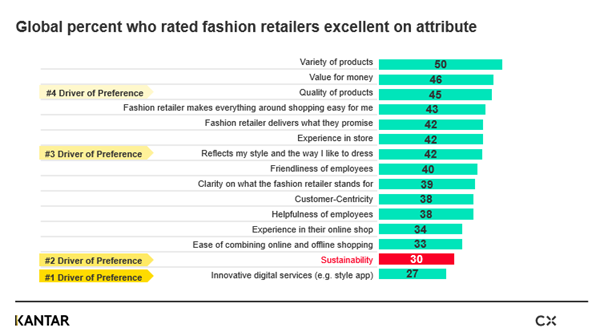Fashion retailers around the world have been hit from both sides during COVID-19, impacting both supply and demand. Wave 5 of the Kantar COVID-19 Barometer finds that almost half (46%) of people say they will delay their return to normal consumer habits because of pandemic-related safety concerns. So, businesses have focused on crisis management and scenario planning. But as the smoke begins to clear, surviving retailers will again look towards finding new sources of opportunity and growth. While offline fashion retail sales have declined, online sales have grown for many retailers — although not always enough to compensate for offline losses.
Before COVID-19, fashion ecommerce was a relatively small, but growing niche, accounting for less than a quarter of category revenue. But Kantar Retail IQ 2020 projections now suggest that even conservative 1% annual global retail growth in online until 2025 would mean it outpaces offline growth by ten times. For the high-street incumbents, online direct-to-customer channels offer both cost-effective customer acquisition and greater profitability. But they must beware the associated loss of brand experience – without physical products to touch and try on, or attention from experienced sales assistants, online fashion retail can struggle to deliver meaningful engagement. Fashion ecommerce brands face a challenge – how to build a brand, without a physical presence on the high street, and the kind of face-to-face interactions that often leave a lasting impression. Meanwhile, legacy bricks-and-mortar natives view ecommerce as a growth channel, but must be wary of associated risks to brand loyalty. How can online services deliver memorable experiences?
In a competitive online market, with high rates of returns, the convenience of fashion ecommerce comes with a flip-side – a risk to brand loyalty. Owning the online direct-to-customer relationship can be a good thing, but only if the experience is memorable. Kantar CX+ 2020 Retail analysis found that just 16% of retail customers were delighted with their most recent interaction. Our research also found that, globally, fashion retailers are score poorly for brand promise, compared to grocery and general retailers. This may be a turning point for fashion ecommerce to transform the online experience, while shoppers remain reluctant to return to stores. We know from BrandZ that brands with strong equity recover faster during a downturn, and we also know that brands that fail to invest in brand equity devalue over time. A key question therefore remains – how do retail brands fully leverage online revenue growth, while building their brands?
Fashion’s future enabled by technology
Artificial intelligence may well play a role in fashion’s recovery. The uniqueness and exclusivity of ‘limited editions’ have long driven loyalty. As fashion brands are waging battle over people’s discretionary spend, new ways of driving demand will be critical. Innovative digital technologies have the potential to deliver the personalisation and customisation that customers value. Building a greater understanding of customer data through artificial intelligence will allow brands to deliver unique experiences and services for segments-of-one.
At-home, 3D printing may also democratise the process, providing customers with on-demand and perfectly fitting products, at the click of a button. Developments such as this flip the business model to sales before manufacture, transforming the traditional ‘push’ fashion supply chain model to a ‘pull’ one. This will reduce supply chain disruption risks and sustainability problems of excess inventory that have plagued fashion recently, while accelerating turnaround from design to delivery. This is particularly important when we consider that CX+ 2020 Retail found that sustainability was the number two global driver of fashion brand preference. See chart below. Customers will be empowered through greater choice and products will become collaboratively created, catering to individual tastes and preferences. Retailers will see healthier finances with increased cashflow, higher profits from less discounting, and lower risk from unsold inventory. The service model to match this new supply model will be an opportunity for creative retailer innovation.

While this future is not quite here yet, vertically integrated retailers and OEMs are advancing this space. Custom knitwear manufacturer Knyttan solved a key integration challenge by programming special design software to bridge the gap between a design customisation interface and the instructions provided to the digital knitting machines. Many global athleticwear and shoe retailers, such Nike with their ‘Nike by You’, have offerings in the custom space.
Innovate to stay ahead
Using recommendation engines to showcase a personalised product selection will soon no longer be enough for tomorrow’s ecommerce retailers. Instead, customer data will underpin a revolutionary process of mass-product and service customisation and personalisation, at an individual level. This creates an opportunity for retailers to engage customers in an immersive experience of collaborative creation, resulting in a more sustainable industry and greater customer brand loyalty online.


